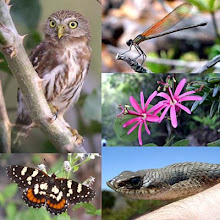September
15, 2015
For this
year’s tour I had added a day to the old itinerary so we could bird the
foothills and interior valley of Lagunillas, a sleepy little town visited by
few people other than travelers interested in the story of Che Guevara. This is
where he formed his band and began his final journey before being killed in
Vallegrazeeeeeeeende northwest of here.
The northern
road into the valley crosses some hills still covered in intact forest, a
rarity in much of Latin America, but not uncommon in sparsely-populated
Bolivia.
It was a
beautiful setting for another wonderful picnic breakfast prepared by Benita and
her brother Carlos.
This odd fly
of an unknown family visited my dish while we were having breakfast, before
which we had seen Sclater’s Tyrannulet, Dot-fronted Woodpecker, and
Crimson-crested Woodpecker.
After
breakfast we continued to bird along the road, where I heard and finally
recognized the song of Southern Antpipit. No published information I had ever
read gave me a clue that this species would be remotely possible here; I hadn’t
heard one in two years, and I’ve only ever seen it twice, so it was quite a
surprise for me. A bit of playback worked wonders, and everyone got great views
of it.
Soon
butterflies became active. This is Mechanitis
lysimnia, a widespread and variable species.
I haven’t
yet been able to identify this Parides sp.
cattleheart swallowtail.
This
metalmark appears to be Emesis ocypore.
And despite
nearly lacking any blue, this is Quadrus
cerialis, Common Blue-Skipper.
We continued
into the valley of Lagunillas, the northern end of which is a huge cattail
marsh and lake just starting to come alive in the early spring. We saw several
Southern Screamers and many ducks and shorebirds. The forest is a bit drier
here, blocked by the ridge to the east, and bromeliads are abundant. This giant
bromeliad somehow managed to find a foothold on the side of a very straight
trunk. The smaller bromeliads in the background are various species of Tillandsia.
This orchid
appears to be an Oncidium species.
This is a Brunfelsia sp., a common genus as an
ornamental (often called “yesterday-today-and-tommorow”), but most are just
showy; this native one is intensely and delightfully fragrant.
At our
picnic lunch spot we flushed a flock of Grayish Baywings (a recent name change
with the Bay-winged Cowbird being split into two species) with two black
cowbirds. Up until now we had seen plenty of Shiny Cowbirds, but I had a hunch,
and with some brief playback I confirmed they were Screaming Cowbirds, very
similar visually as adults. Their primary host is this Grayish Baywing, and the
juvenile Screaming Cowbirds look nearly identical to this species.. Should I
ever get a good photo of a Screaming Cowbird juvenile in profile, the
proportions and size of the bill will be good to compare.
We have one
more night here in Camiri before we head back north for a couple of nights at
Refugio Los Volcanes.





No comments:
Post a Comment